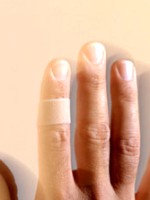|
|
|

Treating Cuts at Home in 5 Easy Steps
By Richard Thomas, MD, FRCPC
We all get cuts and scrapes from time to time, so here are some basic steps to make sure you are decreasing the chance of infection and minimizing scarring:
Step 1: Stop the bleeding
The first priority is to stop the wound from bleeding. This is done by applying firm pressure to the wound using a cloth or towel.
Step 2: Clean the wound
Cleaning the wound is important to minimize the risk of infection and scarring. First rinse the wound with clean water, removing any dirt, gravel or glass. Clean the wound next with sterile gauze.
Step 3: Prevent infection
The best way to prevent infection is to apply a topical antibiotic to the wound and cover it with a dressing. Studies show that applying a topical antibiotic can promote healing in eight days, as opposed to 13 days for wounds left untreated.
Step 4: Close the wound
You can promote healing and minimize the potential for scarring by covering the wound. Scientific studies show that keeping an injured area moist:
- Encourages new tissue to grow
- Decreases the chance of infection
- Reduces scarring
- Lowers the chance of further injury to the cut or scrape
- If the cut is small enough, simply cover the cut with a bandage or dressing after following steps Step 1 through Step 3
Options for closing wounds
There are many ways to close wounds, and the best option will depend on the type and severity of the wound itself.
- Skinstrips are tapeŚlike strips that hold the skin together. These are appropriate for small cuts.
- Stitches (or sutures) are used for deeper cuts. The stitches are used to sew the edges of the cut together.
- Steri-strips are used to close wounds on the face in those instances where stitches may leave a scar. Steri-strips or butterfly strips are thin and sticky, and usually fall off after a few days.
- Skin glue is a special adhesive that sticks together the edges of the wound and seals the skin for protection. Skin glue is not as effective on areas where there is a significant amount of skin movement.
- A liquid bandage forms a seal over the affected area. A significant advantage is that it can be used in areas that are difficult for an ordinary bandage to stay on. The seal is waterproof, promotes healing and helps protect against infection.
Step 5: When to seek medical help
Call your doctor if:
- If the wound is deep, the edges are torn, if fat protrudes from it, if the wound is over half an inch long, if it's a puncture or if it is a gaping wound, you may need stitches
- You are unable to remove dirt, debris, dead tissue, or stop the
- The wound is on the face, eyelids, lips, or neck as you may need medical attention to help prevent scarring
- A tetanus shot is required
For more information about treating cuts and scrapes go to the Skin Care Guide page on Bacterial Infections.
About the author:
Richard Thomas, MD, FRCPC is Assistant Clinical Professor of Dermatology, Department of Dermatology and Skin Science, University of British Columbia, Vancouver, Canada.
|